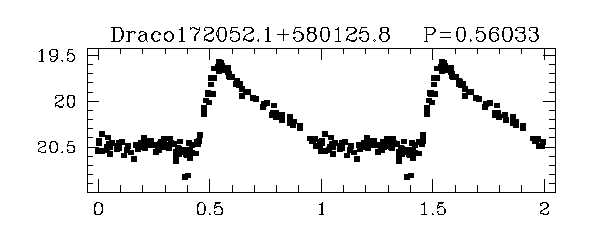
 Copyright © Michael Richmond.
This work is licensed under a Creative Commons License.
Copyright © Michael Richmond.
This work is licensed under a Creative Commons License.
There are many, many types of stars which vary in brightness. Some are single, others are members of binary systems. While they are interesting for their own sakes, a very few of them can be used to help us find distances. But only a few ...
We'll start by discussing how binary stars with JUST the right properties, and with a LOT of observations, both photometric (easy) and spectroscopic (hard), can yield very secure distances. After that, we'll turn to one particular type of pulsating star which can serve as a distance indicator. We'll look at another type in a future lecture.
Some stars show periodic variations with a characteristic light curve shape: a quick rise, followed by a slower decline:


Taken from
Bonanos et al., 2004AJ....127..861B
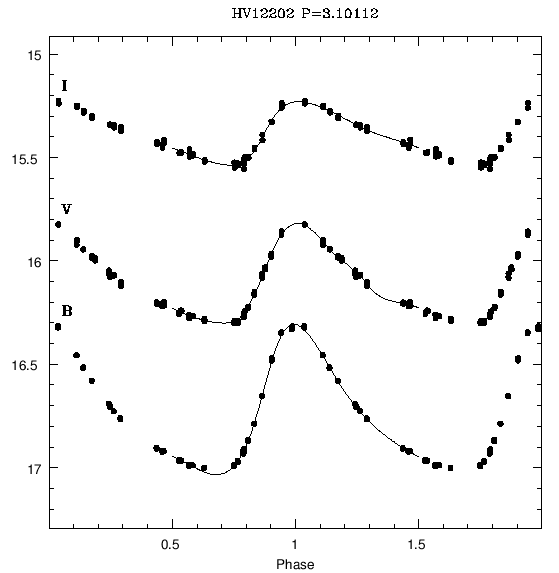
Taken from Musella et al., 2006MmSAI..77..291M
It turns out that these stars change their size, color and luminosity in a periodic manner. The diagram below shows a rough approximation of the relationships.
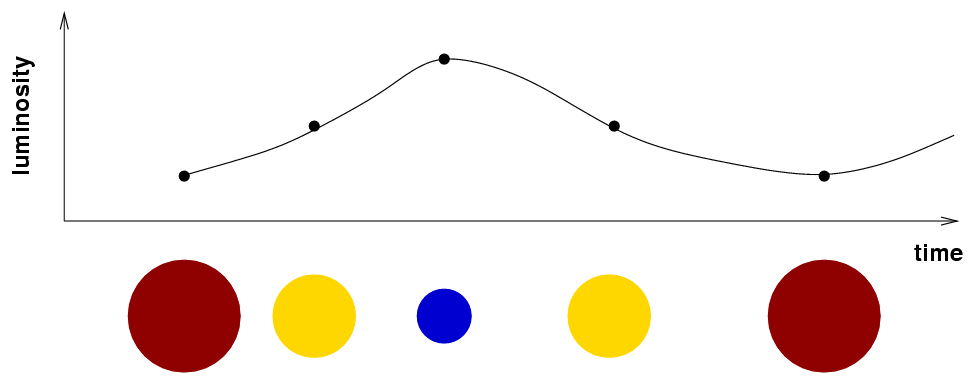
Why do the stars grow and shrink? Hmmm. The answer might make more sense if we first consider a more familiar situation -- a pot of water with a lid, full of water, sitting on a hot stove.
Q: What happens as the water starts to boil?(Click the picture to find out)
As water turns into steam, it presses against the walls of its container. The pressure pushes the lid upwards, against the force of gravity. But when the lid rises high enough to expose a gap through which the steam can escape, the pressure inside the pot drops suddenly. As a result, the lid falls back into place, and the cycle begins anew.
In a way, the same cycle happens inside certain types of stars. Stars don't have REAL lids, of course ... but under certain circumstances, they can contain a sort of lid. It all boils down (hah!) to the interaction of light with atoms.
Ordinary hydrogen, for example, consists of a negative electron attached to a positive proton. The result is a neutral atom.
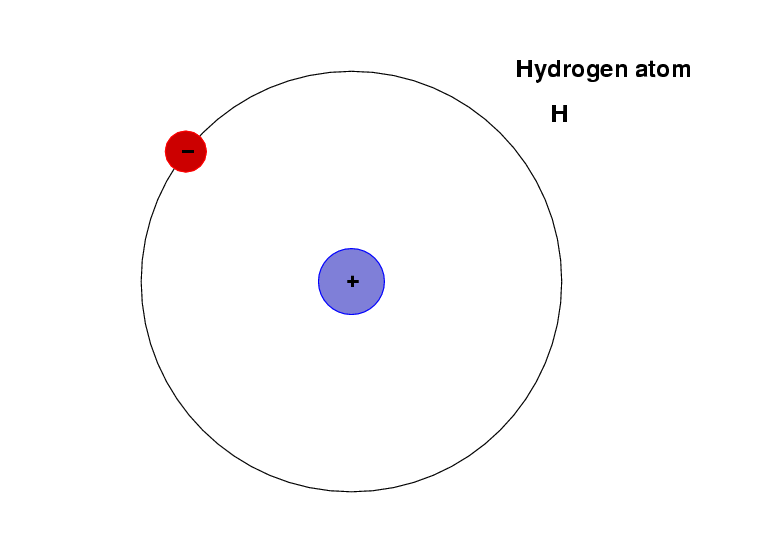
If a photon of ordinary visible light impinges on this atom, it will very probably pass right through it.
Deep inside some stars, the conditions --- temperature, pressure, chemical composition, electron density --- allow a variety of hydrogen to form: the negative hydrogen ion.
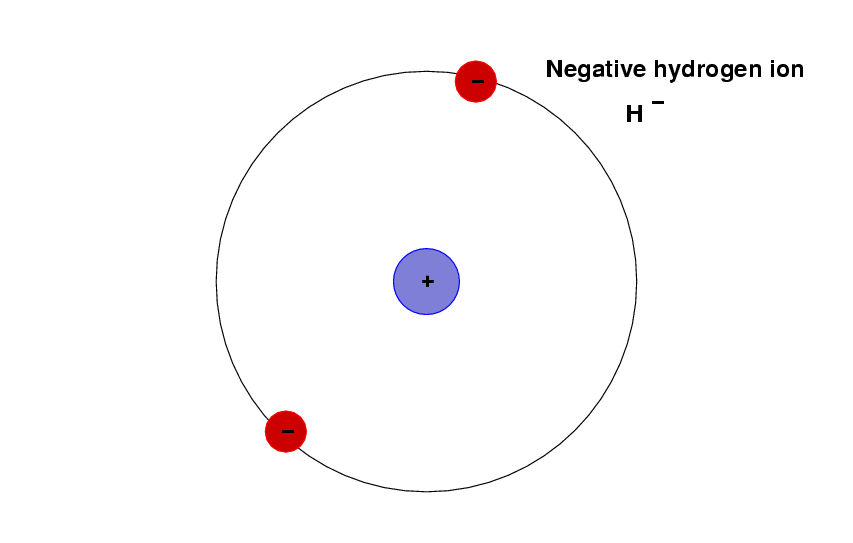
It turns out that the second electron in this ion makes the ion much more likely to interact with passing photons.
So, let's consider a star which has a layer somewhere in its interior which is rich in negative hydrogen ions (or negative helium ions, which behave in a similar manner).
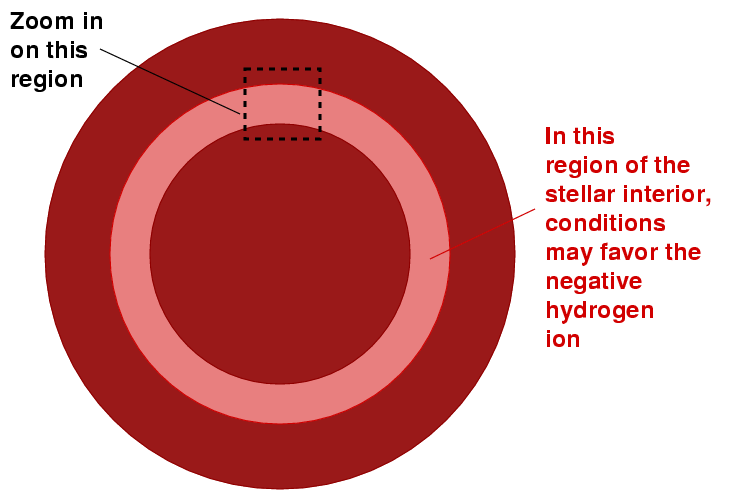
If we zoom in on that region, we see that photons can't pass through it easily. On their way out from the center of the star into space, many of the photons are absorbed by ions. The collisions push the ions in this layer outwards, away from the hot center of the star.
(Click the image to see what happens)
As a result of this instability, the outer layers of the star expand and cool, then contract and heat up, and the star shrinks and grows in brightness.
Which stars suffer from this sort of instability in their outer atmospheres? It turns out that conditions are right only for a relatively small fraction of all stars; most do NOT pulse in any significant manner.
Enough with the theory of stellar interiors. How does this help us to measure distances?
One type of stars, called RR Lyrae stars, form a very homogenous group. They all have roughly the same mass, the same (average) size, the same (average) temperature, and so approximately the same (average) luminosity. This luminosity turns out to be high enough to make them visible throughout our own Milky Way Galaxy, as well as in some of the nearest neighbors of the Milky Way.
Most RR Lyrae stars are relatively old and have masses somewhat less than that of the Sun; ranging from about 0.5 to 0.7 solar masses. They sit in a region of the HR diagram called the instability strip, above the main sequence and at moderate temperature.
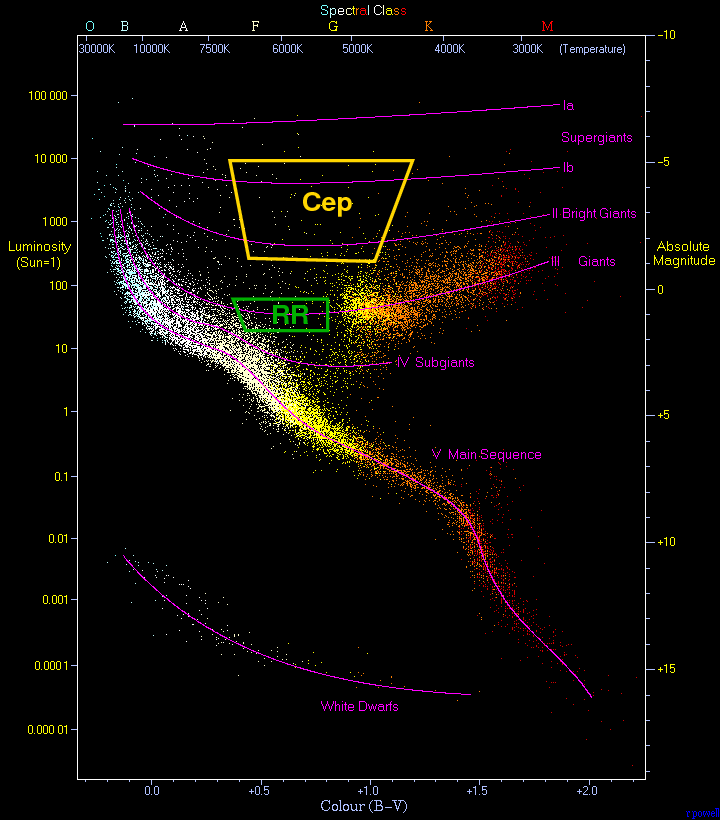
Background image of HR diagram courtesy of
www.anzwers.org
Here's a closeup of the RR Lyrae region in the globular cluster M3, with evolutionary tracks showing the paths of stars with masses ranging from 0.58 to 0.80 solar masses (with the lower-mass models at left).
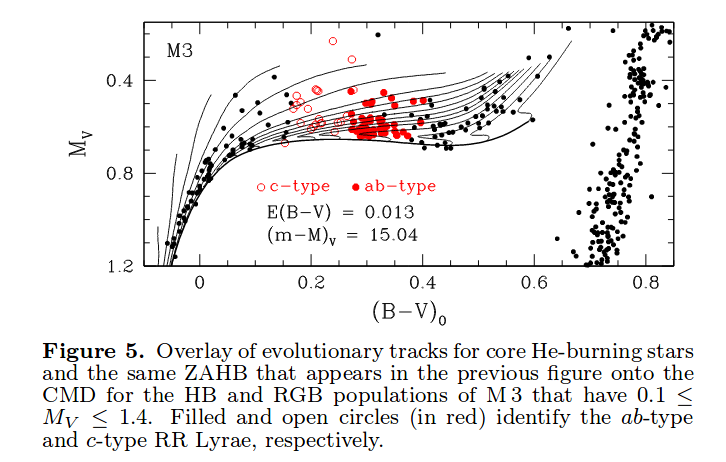
Figure 5 taken from
VandenBerg, Denissenkov and Catelan, ApJ 827, 2 (2016)
RR Lyrae stars are easy to find, because their periods are short -- just 9 to 18 hours or so -- and the amplitude of their variations is large: up to 1 magnitude! You can easily pick out the RR Lyrae stars in this "movie" of M3, which uses images taken during a single night:
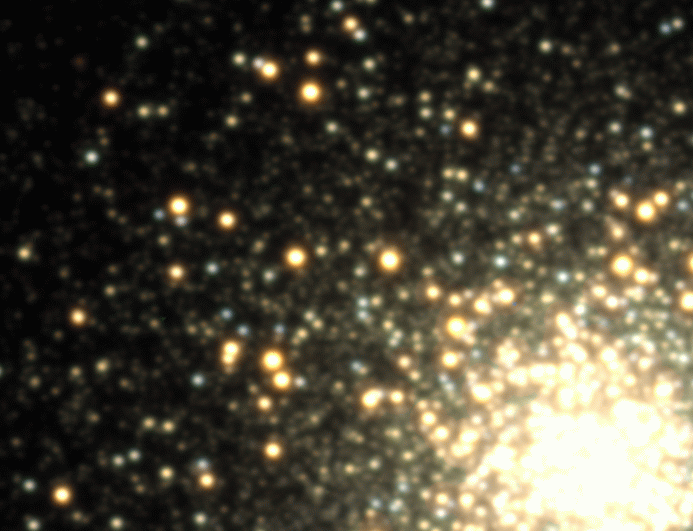
Image courtesy of
Joel Hartman and Kristoff Stanek
Now, to a rough approximation, all RR Lyrae stars have the same luminosity, which makes it very easy to use them as rough distance indicators:
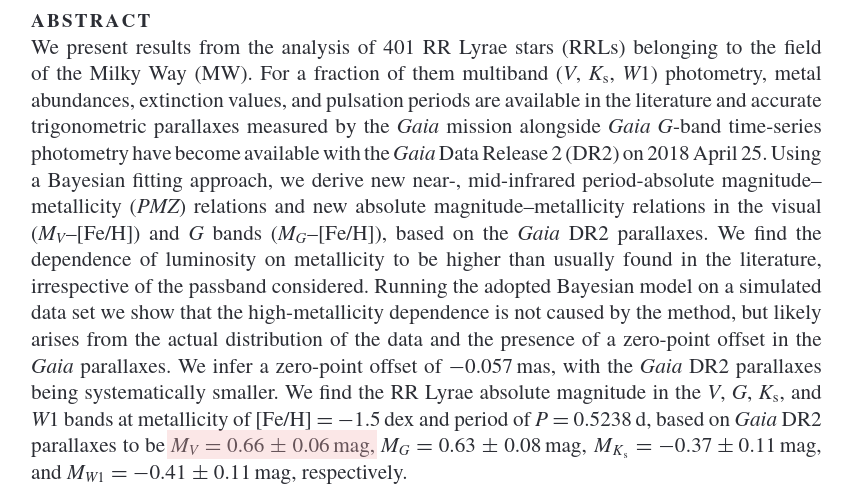
Abstract of the paper
Muravera et al., MNRAS 481, 1195 (2018)
Let's try out this simple method! Bonanos et al. AJ 127, 861 (2004) provide V-band light curves for RR Lyrae stars in a small galaxy called "the Draco Dwarf Spheroidal Galaxy", a member of our Local Group.

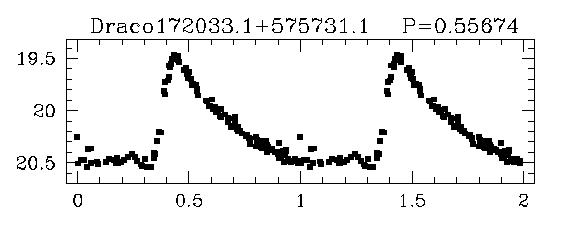
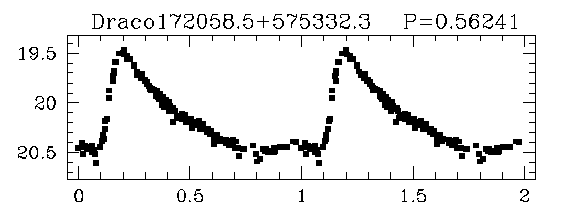
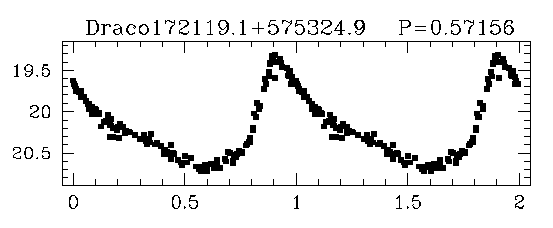
Q: How far from us is the Draco dwarf spheroidal galaxy?
Provide your answer in terms of distance modulus,
and in kpc.
Bonanos et al. (2004) derived a distance of
d = 75.8 +/- 5.4 kpc
to the Draco dwarf galaxy. How does your value compare to theirs?
If you look more closely at the RR Lyrae stars, however, you will see small differences between them.
For example, measurements of 70 RR Lyrae in the LMC show this trend in K-band apparent magnitude:
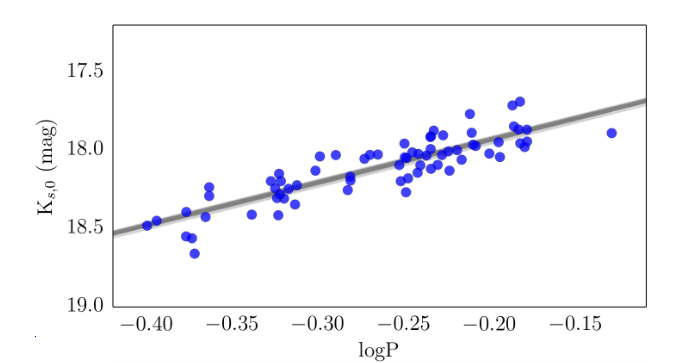
Taken from Figure 2 in
Muraveva et al., ApJ 807, 127 (2015)
which is mirrored closely by a set of 23 RR Lyrae measured within our own Milky Way:

Taken from Figure 3 in
Muraveva et al., ApJ 807, 127 (2015)
Q: Can you write down a mathematical equation that provides
the absolute magnitude in K-band, MK,
as a function of period (or log of period)?
If you look even MORE closely, you'll see that the class of "RR Lyrae" stars can be divided into several sub-classes: the RRa and RRb stars, often grouped together into RRab, which have the classic asymmetrical light curve shapes and periods of 12 to 17 hours; and the RRc stars which have more sinusoidal light curves and somewhat shorter periods.
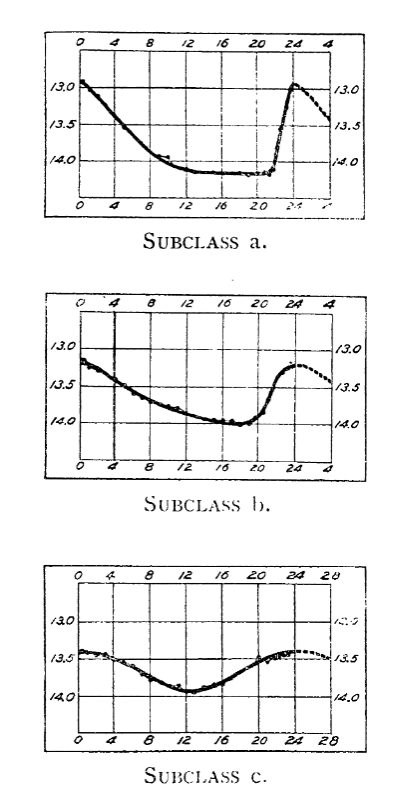
Taken from Plate VII of
Bailey, S. I., Annals of the Astronomical Observatory of Harvard College,
vol 38 (1902)
Within each group, we see again that stars with longer periods have slightly high luminosities.
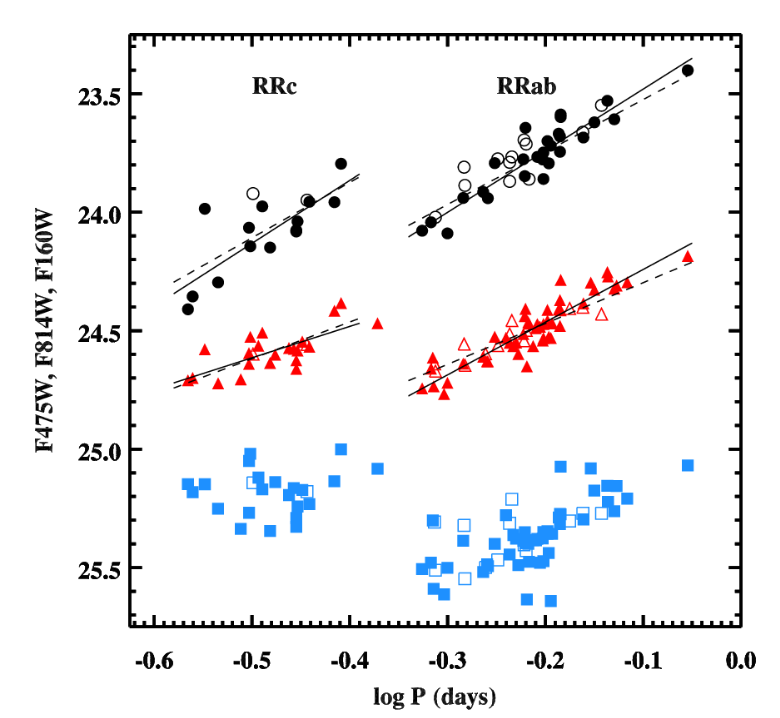
Figure 8 taken from
Hatt et al., arXiv:1703.06468 (2017)
So, if you want to make the best distance measurements using RR Lyrae stars, you will need to account for both the period and chemical composition of the stars in your sample. If you do, the payoff could be big: Neeley et al., arXiv:1705.01970 (2017) suggest that if one properly takes into account the period and metallicity of a star (and the extinction along the line of sight), then one can predict its mid-infrared absolute magnitude with an uncertainty of only 0.02 magnitudes!
Let's do a simple example: we'll account for the period of the star, but not the metallicity. Kumar et al., MNRAS 531, 2976 (2024) present measurements of RR Lyr stars in the globular cluster M3. Below is the light curve of one of their stars, V6, in the I-band:
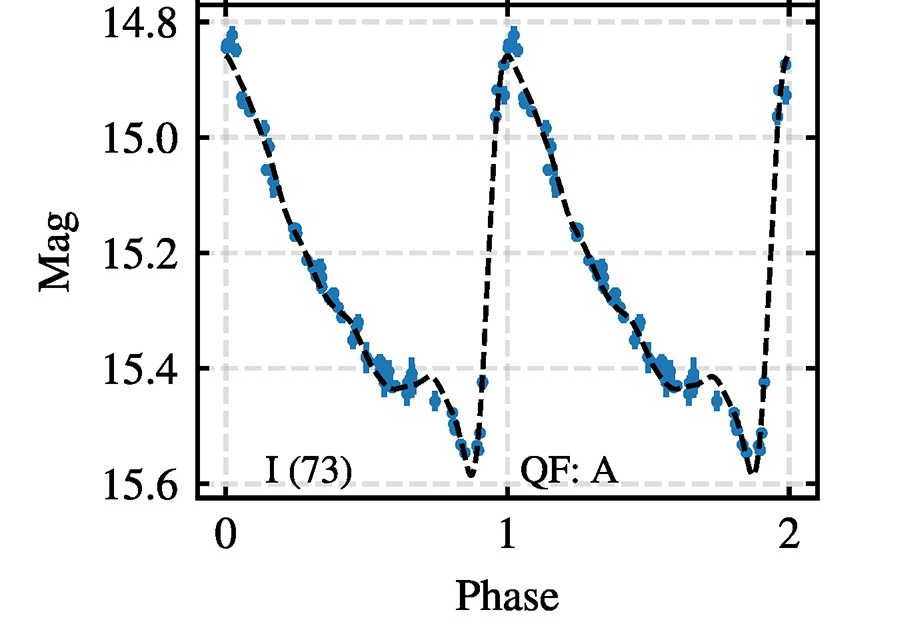
Taken from Figure 4 of
Kumar et al., MNRAS 531, 2976 (2024)
Q: What is the average I-band apparent magnitude of the star?
The authors determine the period of this star to be P = 0.514336 days. One can compute the absolute magnitude in I-band using the following relationship:
M(I) = -0.36 - 1.804 log(P)
Can you use this information to determine the distance to this RR Lyr star?
Q: What is the absolute magnitude of the star, M(I)? Q: What is the distance modulus, m(I) - M(I)? Q: What is the distance, in pc?
How close is this to other distance estimates for globular cluster M3?
 Copyright © Michael Richmond.
This work is licensed under a Creative Commons License.
Copyright © Michael Richmond.
This work is licensed under a Creative Commons License.